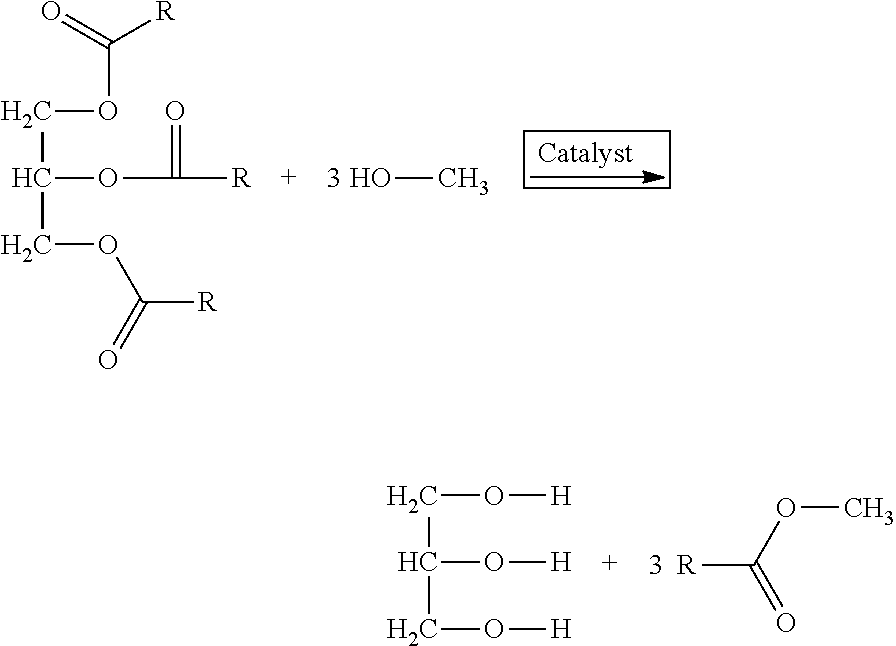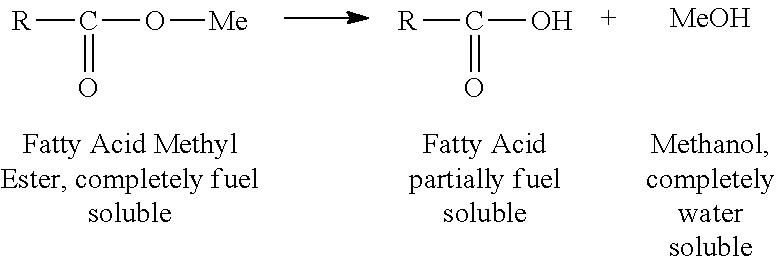Determination of fame content in fuel
a technology of fame content and fuel, applied in the direction of material testing goods, instruments, analysis by subjecting materials to chemical reactions, etc., can solve the problems of supply chain, trace levels (parts per million) of fame from diesel products known to contaminate other fuel products, and jet fuel is not suitable for purpos
- Summary
- Abstract
- Description
- Claims
- Application Information
AI Technical Summary
Benefits of technology
Problems solved by technology
Method used
Image
Examples
example 1
Preparation of Control Sample
[0050]In an open laboratory held at about 20° C., a quantity of rapeseed methyl ester (RME) was added to 5 litres of Jet A-1 fuel in a portable hand-held fuel can, so as to provide a FAME concentration of 50 ppm (mg / Kg). 500 ml of the jet fuel comprising RME was extracted from the fuel can as a test sample and put into an open beaker. 50 ml of DI water, 505 mg of hydrolase and 505 mg of lipase were added to the beaker and the contents mixed vigorously. After about 10 seconds, the contents had settled, providing a clear water phase at the bottom of the beaker and a clear fuel phase on top of the water phase.
[0051]Immediately thereafter, using a pipette, 10 ml of the water phase is extracted from beneath the fuel phase and placed into a sealed first test tube.
[0052]A 1 ml portion of the extracted water phase is then extracted from the test tube and evaluated for methanol content using GCMS. It can be determined that the water phase contained methanol in a ...
example 2
Preparation of Test Samples
[0053]Two differing amounts of RME were added to a second and a third portable hand-held fuel cans each containing 5 litres of Jet A-1 fuel, so as to provide a FAME concentration in the second can of 40 ppm and a FAME concentration in the third can of 60 ppm. 500 ml of the jet fuel comprising RME is extracted from each fuel can and put into two open beakers.
[0054]50 ml of DI water, 505 mg of hydrolase and 505 mg of lipase are then added to each beaker and the contents mixed vigorously for 3 minutes. After about 10 seconds, the contents settle out, so providing a clear water phase at the bottom of the beaker and a clear fuel phase on top of the water phase.
[0055]Immediately thereafter, using a pipette, 10 ml of the water phase from each beaker was extracted from beneath the fuel phase and placed into two sealed second and third test tubes.
example 3
Determination of FAME Concentration Using a Breathalyser Device
[0056]A hand-held breathalyser, as may be used by police for taking breath tests from motorists suspected of driving with alcohol levels over the legal maximum, e.g. ALCOSENSE ZENITH+breathalyser (AlcoSense), is modified to receive vapourized contents of the first test tube at 37° C. for 5 seconds, and the breathalyser adjusted to calibrate it to indicate 100 on the visual display.
[0057]Vapourized contents of the second test tube at 37° C. are then passed in to the breathalyser for 5 seconds and the display observed. The display indicates a reading less than 100.
[0058]Vapourized contents of the third test tube at 37° C. are then passed in to the breathalyser for 5 seconds and the display observed. The display indicates a reading more than 100.
[0059]From the above, it can be determined that the second fuel can contains less RME than the analogous control sample and the third fuel can contains more RME than the analogous c...
PUM
 Login to View More
Login to View More Abstract
Description
Claims
Application Information
 Login to View More
Login to View More - R&D
- Intellectual Property
- Life Sciences
- Materials
- Tech Scout
- Unparalleled Data Quality
- Higher Quality Content
- 60% Fewer Hallucinations
Browse by: Latest US Patents, China's latest patents, Technical Efficacy Thesaurus, Application Domain, Technology Topic, Popular Technical Reports.
© 2025 PatSnap. All rights reserved.Legal|Privacy policy|Modern Slavery Act Transparency Statement|Sitemap|About US| Contact US: help@patsnap.com


